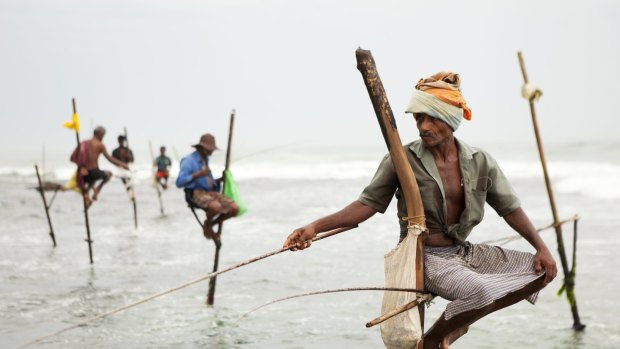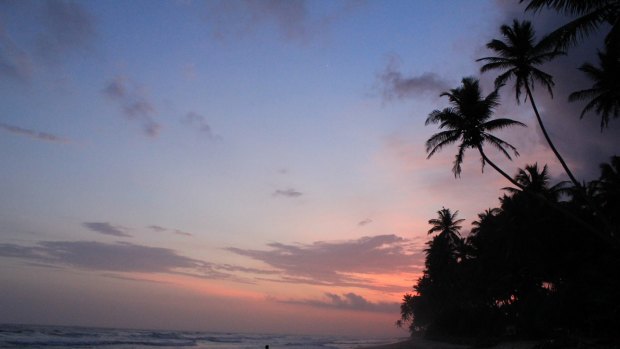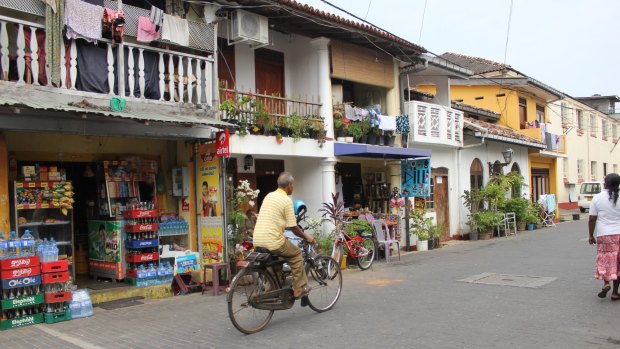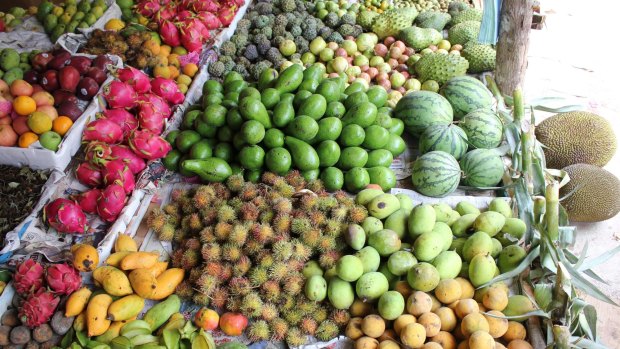This was published 9 years ago
Galle and surrounds, Sri Lanka
Ten years on from the tsunami that devastated the island's low-lying coastal communities, the Sri Lankan people's resilience and warmth is touching, writes Effie Mann.
By Effie Mann

Cultural mosaic: At its heart Sri Lanka's essence is captured best in the multitude of spices and stilt fishing that are native to these parts.Credit: Getty Images
"I read in a book that in Australia you have this season called 'vinter' and it is unbearably cold," says our elderly guide in a spice garden outside Galle. In the heavy, fragrant humidity Melbourne's chill is a world away, but we still take heed when he shares that cinnamon gel rubbed behind the ears has a warming effect. "How is my English?" he asks, inviting praise. Very good, we tell him. "Good. Then we can communicate," he says proudly.
Sri Lanka is no stranger to visitors, including some uninvited ones. Invaded by the Portuguese in 1505, the country later fell to the Dutch, before the British made it a colony in 1802. A long line of traders, immigrants and colonisers have had a hand in moulding this diverse nation's culture, but at its heart Sri Lanka's essence is captured best in the multitude of spices and stilt fishing (that is, fishing on stilts) that are native to these parts.
It has been 10 years since the tsunami devastated the island's low-lying coastal communities, and not long since peace descended following years of civil war. After such hardship and heartbreak the Sri Lankan people's resilience and warmth is affecting.

Picturesque place: As the palm trees fade to silhouettes, we choose our fish from the day's catch and sup to the sound of the Indian Ocean.
Here in the herb garden, inland from the beach settlement of Unawatuna, we find natural remedies used for centuries to ease the pain of arthritis, cure stomach aches, beat high and low blood pressure, and mend acne and scarring. The best seller among tourists? The herbal hair removal cream, apparently, and we're given an unsolicited demonstration by way of my partner's hairy leg. (On re-joining friends later, we're amused to find them sporting matching bald patches, courtesy of an equally enthusiastic sales pitch at another spice garden.)
We skirt the city of Galle, and then enter the fortress walls that hug this European settlement and seem to buffer it from the dusty humidity beyond. Here, the 17th century streets are heavy with Dutch and British influence: quaint tea houses, jewellery shops gleaming with gem stones, fancy art galleries.
A rising number of boutique hotels and guest houses mingle with cheaper hostel accommodation. Stray dogs wander the streets. A woman sells beautiful home-made lace from her veranda. Boys play cricket under an ancient, shady peppercorn.

European settlement: Galle's 17th century streets are heavy with Dutch and British influence.
The Galle oval serves as a great talking point for cricket-mad locals. "Warnie played there," we are told often. But sport, or rather, cricket, is just one part of a cultural mosaic that incorporates the Galle National Museum – where ancient wooden carvings and European porcelain cohabit in the oldest Dutch building of the Galle fort, dating to 1656.
We climb the stairs of Mama's Galle Fort Roof Cafe for some perspective and shade and enjoy a cheap spread of what is widely referred to as 'rice and curry', but is an understatement. We feast on curry served with a medley of delicious dhal, sweet-and-sour eggplant, curried beetroot and colourful chutneys.
Galle's near-neighbour, Unawatuna, has healed since 2004, with tourists again filling its resorts and luxury villas, its bars and cafes.

Teeming with delicacies: Trucks pulled to the side of the road are impromptu stalls for mounds of watermelons and coconuts.
Tucked between the sand and the main road, the sea turtle "farm" at Habaraduwa (opened in 1986) charges 400 rupees ($3.20) entry to view the five concrete tanks that house energetic youngsters and rather cramped older turtles. Of the world's seven turtle species, five can be found here in Sri Lanka, but poachers and natural predators threaten their survival.
Our tuk-tuk driver (who appears to have spent much more on his subwoofer than the mechanics of his vehicle) carries us further south, where the road opens up as traffic thins. We pass stilt fishermen, propped out to sea, their catch dangling from bags at their waists, and the surf break of Midigama. We stop and take refreshments: thambili (king coconut) opened by machete and sipped through a straw.
Later, following an afternoon of swimming at tiny surfside outpost Mirissa – where miniature squirrels scamper and pineapples hang overhead – we move lazily from sun bed to cafe table. As the palm trees fade to silhouettes, we choose our fish from the day's catch and sup to the sound of the Indian Ocean and reggae played by our Rastafarian host. Darkness falls and the table lanterns are mirrored out to sea as fishermen light their night's work. We've journeyed from British colony to island paradise.
Flights:
Singapore Airlines operates daily connections to Colombo, Sri Lanka's largest city, from Melbourne via Singapore, from $1268.57 return.
Don't miss:
Set aside time wander the historic Galle fort, and enrol in a cookery course with Karuna at Sonja's Healthfood Restaurant in Unawatuna, where you'll take a tour of the Galle market to gather fresh provisions and transform them into delicious curry.
Must taste:
Part of the fun of travel is sampling new cuisine and Sri Lanka is simply teeming with delicacies. Try street snacks 'hoppers' (crispy, bowl-shaped pancakes made with rice flour, best topped with fried egg, red onions, spices and chutney) and 'kottu rotti' (pancake chopped and fried with meat and vegetables). There are many different types of bananas to work your way through, and amazing fruit stalls to trawl. The zingy and delicious local fruit called 'magosteen' is also worth a taste.
Sign up for the Traveller Deals newsletter
Get exclusive travel deals delivered straight to your inbox. Sign up now.